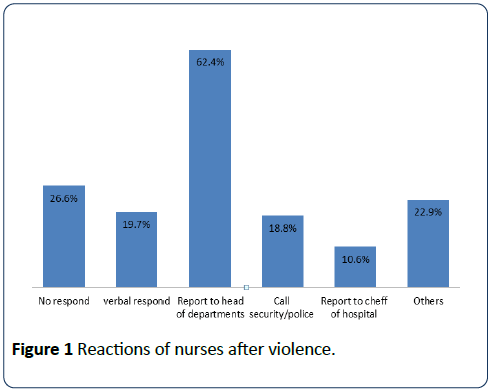Workplace Violence against Healthcare Nurses in the Vietnam National ChildrenÃÆâÃâââ¬Ãâââ¢s Hospital: A Cross Sectional Study
Pham Thu Hien1*, Dao Ngoc Phuc2, Le Thi Thu Trang2 and La Ngoc Quang3
1Human Resources Department, National Children’s Hospital (NCH), Hanoi, Vietnam
2Emergency and Poison Control Department, National Children’s Hospital (NCH), Hanoi, Vietnam
3Department of Undergraduate Education Management, Department of Epidemiology, Hanoi University of Public Health, Hanoi, Vietnam
- *Corresponding Author:
- Pham Thu Hien
Chief of Human Resources Department of National Children’s Hospital (NCH)
Hanoi, Vietnam
Tel: (84) 912504089
E-mail: hienkhth@yahoo.com
Received Date: March 03, 2019; Accepted Date: April 19, 2019; Published Date: April 30, 2019
Citation: Hein PT, Phuc DN, Trang LTT, Quang LN (2019) Workplace Violence against Healthcare Nurses in the Vietnam National Children’s Hospital: A Cross Sectional Study. J Health Hyg Vol.3 No:1:2.
Copyright: © 2019 Hien PT, et al. This is an open-access article distributed under the terms of the Creative Commons Attribution License, which permits unrestricted use, distribution, and reproduction in any medium, provided the original author and source are credited.
Abstract
Violence in health care settings becomes a concern worldwide. However, the problem is still under researched in Vietnam.
Objectives: To calculate the prevalence of violence against nurses and associated factors in the national children hospital.
Subjects and methods: A cross sectional study included 317 nurses from January to December of 2017. The questionnaire was contributed from the question tools of the International Labour Office, the International Council of Nurses and the World Health Organization.
Results: The prevalence of workplace violence in nurses was 72.7%. More than 75% of nurses experienced violence, and verbal abuses were the most common. Around 25% of participants were victims of physical assaults. The regression analysis showed that nurses working in the emergency department and Outpatient clinic were 1.92 times more likely to suffer verbal abuses than those working in other departments. They also were 3.02 times significantly more likely to have physical violence.
Conclusion: Violence mostly occurred in the emergency department and outpatient clinics. Verbal abuses were the most common.
Keywords
Workplace; Violence; Nurse; Hospital
Introduction
Recently, violence against health care workers has been increasing in many countries. Research showed that violence in workplaces such as verbal abuse, and threatened or actual physical violence, is an important challenge faced by physicians and nurses in the hospitals. They frequently have to contact with patients who suffer illnesses and pain, and aggressive visitors who are worried about their relative patient conditions. Besides that, caregivers are usually anxiety and may be depress due to profound problems in finance, work leaves and health [1,2]. Violence in workplaces can lead to stress and mental health issues. Moreover, it contributes to the reduction of work outcomes and increases of service cost. Systematic study summaries that cost of treatment for a nurse after suffering violence may go up to 31.643 USD [1].
Despite of the problem, there has been little data on the issue in Vietnam. Overload in hospitals as well as poor infrastructures are told to relate to the problem of violence in many hospitals in the country. Many nurses said that they have stress, depression and traumas after violence, but the legislation barriers and protection policy are not strong enough to protect health care workers. It is needed to conduct a research to clarify the problem and related factors.
The study was conducted in the national children hospital in 2017 to collect data on violence in health care settings with the aim to calculate the prevalence of violence against nurses and associated factors in the national children hospital.
Subjects and Methods
Subjects
Inclusion criteria: Nurses work in the Vietnam National Children’s Hospital, and agreed to participate in the study.
Exclusive criteria: Nurses do not agree to participate to the study nurses have less than 6 months of working.
Study setting: the study was conducted in the Vietnam National Children’s Hospital, from 04/2017 to 07/2017.
Methods: Study design: A cross sectional study.
Sample size: Used the simple random sampling to calculate the sample size, with the prevalence of violence were of 0.75 (Ucmak 74.5%) with 95% of confident interval and deviation of 6% [3]. The calculated sample size were 288 with 10% of participants were assumed to miss, the final sample size were 317 nurses.
Research Questionnaire
The questionnaire was developed based on the screening tool for workplace violence against nurses of Egypt in 2014 of
Data Collection
associated factors, magnitude and results of violence, perpetrators' details, history of additives of perpetrators, overload of the hospital, the transparent in finance and services, communication, culture, language and behaviors of nurses, waiting time, safety in the workplace.
Data Analysis
Data was cleaned and analyzed by SPSS 20.0. Pearson’s chisquare analysis was used to test the differences in exposure to physical and non-physical violence. Odds ratios and 95% confidence intervals were used to assess potential associations using logistic regression model.
Ethical Approval
The research was approved by the IRB of Hanoi University Public and the Vietnam National Children ’ s Hospital. The decision was made (220/2017/YTCC-HĐ) in March of 2017.
Results
317 nurses of Hospital participated in the study. The majority was females (89.3%); participants with bachelor and under bachelor levels were similar (42% and 43% respectively), 1.7% nurses had postgraduate level. It was about 49% of nurses under 30 years old.
Most of them directly took care of patients (82.7%); and 79% worked in the inpatient departments. Nurses having less than 10 year working were high (72%); 90.7% of them had more than 4 night shifts per month. 99.3% directly took care of patients and 96.3% performed interventions.
Violence against nurses
72.7% nurses exposed to violence; 30.7% exposed to physical assaults and 65.3% were non-physical assaults.
The study results according to Table 1 indicated that 87% of nurses exposed to verbal abuses, and 17.33% were bit or pushed; around 3% were chasing and threated by weapon.
| Characteristics | Frequency | Percentage |
|---|---|---|
| Violence | 218 | 72.7 |
| Physical assalts | 71 | 30.7 |
| Non physical assaults | 196 | 65.3 |
| Non physical assaults | ||
| Verbal abuses | 261 | 87 |
| Threats | 87 | 29 |
| Others | 20 | 6.67 |
| Physical assaults | ||
| Hitting, pushing | 52 | 17.33 |
| Bitting, eating | 18 | 6 |
| Throwing furnitures | 23 | 7.67 |
| Using weapons | 8 | 2.67 |
| Violence in areas | ||
| Emergency departments | 110 | 50.5 |
| Inpatient clinics | 80 | 36.7 |
| Outpatient clinics | 81 | 37.2 |
| others | 5 | 2.3 |
| Perpetrators of violence | ||
| Patients | 5 | 2 |
| Caregivers | 184 | 85 |
| Both of them | 27 | 13 |
| Effects of violence | ||
| Stress | 195 | 89.4 |
| Anxiety | 202 | 92.7 |
| Depression | 95 | 43.6 |
| Reduce effectiveness of work | 166 | 76.1 |
| Trauma | 91 | 41.7 |
| Want to change jobs/positions | 58 | 26.6 |
Table 1 Characteristic of violence.
Emergency rooms were the most common places where violence happened (50.5%); Outpatient clinics were the second (37.2%). 85% of perpetrators were parents and caregivers. 89.4% of nurses reported having stress, anxiety 92.7%; depression 43.6%, 41.7% physical trauma; 26.6% wanted to change their positions.
There were 26.61% of nurses did not say or want to talk about the violence they suffered (Figure 1).
62.4% of nurses reported to the head of the departments they worked. Only 18.8% called the police or security of the hospital.
Working in the emergency department and outpatient clinics increased the risk of violence 2.02 times (95%CI: 1.03-4.10, p=0.048).
Unsuitable relationship between caregivers/patients and nurses could increase the risk of violence 2.32 times (95%CI: 1.36-3.96, p=0.02) from Table 2.
| Factors | Workplace violence | p | OR | |
|---|---|---|---|---|
| Yes | No | (CI 95%) | ||
| Age | ||||
| ≤ 30 | 101 | 46 | 0.131 | 0.67 |
| >30 | 117 | 36 | (0.41-1.13) | |
| Gender | ||||
| Males | 25 | 7 | 0.464 | 1.39 |
| Females | 193 | 75 | (0.58-3.34) | |
| Working experience | ||||
| ≤ 10 years | 158 | 58 | 0.443 | 1.08 |
| >10 years | 60 | 24 | (0.51- 2.83) | |
| Education | ||||
| Bachelor and over | 102 | 29 | 0.075 | 1.61 |
| Under bachelor | 116 | 53 | (0.95-2.72) | |
| Work places | ||||
| Outpatient clinics and ED | 52 | 11 | 0.048 | 2.02 |
| Inpatient clinics | 166 | 71 | (1.03-4.10) | |
| Work shift | ||||
| Yes | 84 | 33 | 0.786 | 0.93 |
| No | 134 | 49 | (0.55– 1.56) | |
| Night shift | ||||
| >4 nights | 200 | 72 | 0.296 | 1.54 |
| ≤ 4 nights | 18 | 10 | (0.68– 3.50) | |
| Patient–nurse communication | ||||
| Not good | 165 | 47 | 0.02 | 2.32 |
| Good | 53 | 35 | (1.36– 3.96) | |
Table 2 Risk factors associated with workplace violence.
Discussion
The result showed that the prevalence of workplace violence in the Vietnam National Children ’ s Hospital in 2017 were considerable high (72.7%). The prevalence of non-physical assaults was higher than the one of physical assaults (65.3% and 30.7% respectively). 87% of nurses exposed to verbal abuses, but only 29% were threats. 17.33% of nurses were bitten or pushed, and a small number of around 3% were chasing and threated by weapon. Our numbers were similar to those of Pai & Lee and Park et al. [4-6]. Other research in Vietnam from Ha The Tuan and Nguyen Thi Bich Diep showed smaller prevalence of verbal abuse than ours. That could be explained by the different samples from different hospitals. Ha The Tuan and Nguyen Thi Bich Diep collected data from local health care units from different provinces to major hospitals [7,8]. Our sample represented to the nurses working in the National children hospital. The prevalence of verbal abuse and physical assaults in our study were smaller than those of Pinar and Ucmak from the emergency department in Istanbul (91.4% and 74.9% respectively) [3]. The differences were due to the different samples. The Istanbul research collected data from the emergency department where the risk of violence was the highest.
Our findings indicated that perpetrators from caregivers and families were high than from patients. 2% of perpetrators were from patients, which were significantly smaller than those from the study of Saudi Arabia (71.5%) [9], Fisekovic Kremic from Serbia [10] and Ebrima from Gimba [11] (33.6%). Patients in our study were children, and most of them under 6 years old. That why the percentage of violence perpetrated by patients was low.
The study showed that violence in emergency department were the highest (50.5%). That were similar to other research such as the study of Ebrima in Gambia which reported that violence were common in Emergency and Outpatients clinics [11].
Our findings indicated that age and gender did not relate to the risk of violence. Our results were different to others. A research in Egypt in 2006 found a relationship between violence and ages as well as genders [12]. Young nurses in Thailand had 80% higher risk of violence than older nurses [14]. Kitaneh and Hamdan found that nurses with less experience and those with lower education had a higher risk of suffering violence [13,14].
In this study, work shifts and departments related to the risk of violence. Nurses worked more than four nights had a higher risk. Working areas also related to the risk of violence. Nurses in emergency and outpatient clinics were two times more likely to expose to violence. Those were no different from other research. Jiao found the same association [15]. Our findings also indicated that nurses who did not communicate well were 2.3 times more likely to have violence (both physical and nonphysical assaults) (95%CI: 1.36–3.96, p=0.02).
The study also revealed that workplace violence affect nurses in term of physical and mental health. It was reported that 89.4% of nurses had stress, 92.7% had anxiety, 43.6% had depression, 41.7% had physical trauma, and 26.6% wanted to change their positions or jobs. Despite of the severity, a large number of nurses did not report to the police or securities. There were 26.61% of nurses did not say or want to talk about the violence they suffered. 62.4% of nurses reported to the head of the departments they worked. Only 18.8% did call the police or securities of the hospital. It might suggest that nurses were not protected well against violence. It was needed to strengthen the system to set up safer environments in the hospital.
Conclusion
The prevalence of workplace violence in nurses in the Vietnam National Children’s Hospital was 72.7%. Non-physical assaults were the most common. Around one fourth of nurses were pushed or bitten, the numbers of threats by weapons were small.
Nurses working in the emergency department and outpatient clinics were 3 times more likely to exposure to violence (3 times) as well as non-physical assaults (2 times). Communication was also related to workplace violence.
References
- Gates DM, Gillespie GL, Succop P (2011) Violence against nurses and its impact on stress and productivity. Nurs Econ 29: 59-66.
- McKoy Y, Smith MH (2001) Legal Considerations of Workplace Violence in Healthcare Environments. Nurs Forum 36: 5-14.
- Pinar R, Ucmak F (2011) Verbal and physical violence in emergency departments: a survey of nurses in Istanbul, Turkey. J Clin Nurs 20: 510-517.
- International Council of Nurses, Public Services International, World Health Organization, International Labour Office (2012) Framework guidelines for addressing workplace violence in the health sector. The training manual, International Labour Office, Geneva.
- Pai HC, Lee S (2011) Risk factors for workplace violence in clinical registered nurses in Taiwan. J Clin Nurs 1405-1412.
- Park M, Cho SH, Hong HJ (2015) Prevalence and Perpetrators of Workplace Violence by Nursing Unit and the Relationship Between Violence and the Perceived Work Environment. J Nurs Scholarsh 47: 87-95.
- Diệp NB (2009) Research on labor and health conditions of health workers, propose a number of policy regime solutions. Dissertation of public health doctoral doctor, National Institute of Hygiene and Epidemiology.
- Tấn HT (2010), Study some risk factors that adversely affect health workers' health and propose intervention measures, Dissertation of Medical Doctoral and Military Medical Practitioners.
- Al-Turki N, Afify AAM, Al Ateeq M (2016) Violence against health workers in Family Medicine Centers. J Multidiscip Healthc 9: 257-266.
- Kremic MBF (2016) Encouraging employees to report verbal violence in primary health care in Serbia: A cross-sectional study. Zdr Varst 56: 17.
- Sisawo EJ, Ouédraogo SYYA, Huang SL (2017) Workplace violence against nurses in the Gambia: mixed methods design. BMC Health Serv Res p: 311.
- Abbas MAF (2010) Epidemiology of Workplace Violence against Nursing Staff in Ismailia Governorate, Egypt. Egypt Public Health Assoc 85: 29-43.
- Kitaneh M, Hamdan M (2012) Workplace violence against physicians and nurses in Palestinian public hospitals: a cross-sectional study. BMC Health Serv Res.
- Kamchuchat C (2008) Workplace Violence Directed at Nursing Staff at a General Hospital in Southern Thailand. J of Occup Health 50: 201-207.
- Jiao M (2015) Workplace violence against nurses in Chinese hospitals: a cross-sectional survey. BMJ Journals P: 5.

Open Access Journals
- Aquaculture & Veterinary Science
- Chemistry & Chemical Sciences
- Clinical Sciences
- Engineering
- General Science
- Genetics & Molecular Biology
- Health Care & Nursing
- Immunology & Microbiology
- Materials Science
- Mathematics & Physics
- Medical Sciences
- Neurology & Psychiatry
- Oncology & Cancer Science
- Pharmaceutical Sciences

